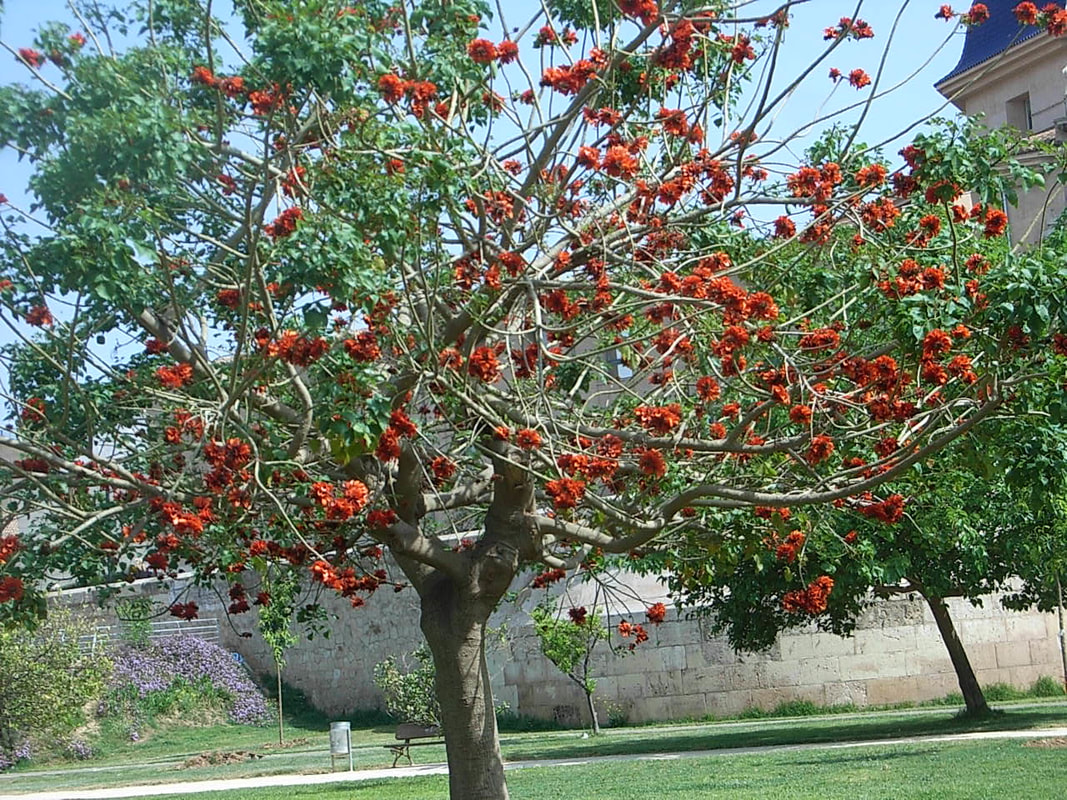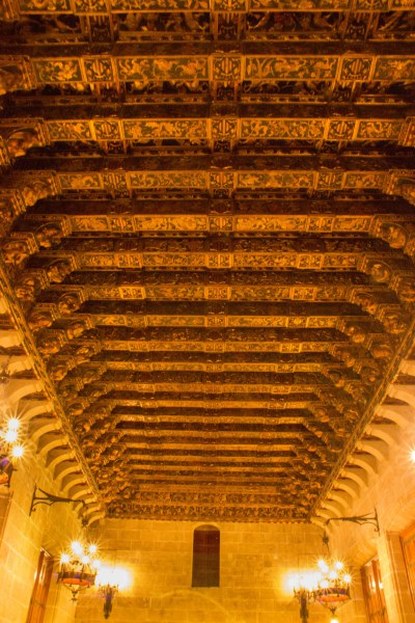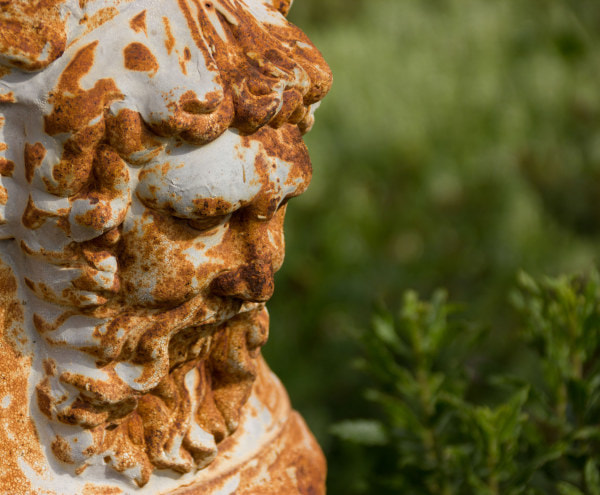Costa Blanca tour 15-22 April 2018
Day 1: 15 April – Arrival in Elche

Members arrived in the city of Elche by plane, train and car throughout the day. The large numbers of palm trees lining the streets were immediately striking and gave the whole area a somewhat exotic air. There were 35 of us in total staying in two hotels, the Tryp Ciudad de Elche and the Hotel Huerto del Cura. On our first evening it was wonderful to be able to sit outside in the beautiful grounds of our hotel enjoying the delicious and interesting variety of local food. Heather introduced us to Carol and Alan Hawes, who own a garden that we would visit the next day and who would accompany us throughout our stay in Elche. The drinks and conversation flowed as we made new acquaintances and caught up with old friends.

Our first visit was to Carol and Alan’s garden. Some 18 years ago they bought a plot of more than two acres with the right to agricultural water (average annual rainfall is eight inches). Living in their motor caravan for three years before their house could be built and tending the plants they had brought from England, gave them time to plan their garden which started with sowing 40 species of eucalyptus to make a wood. Gradually other areas were created making separate beds for Australian, American and African plants, many grown from seed. Growing on the side of the house was a fine and impressive Distictis buccinatoria. There is a rose garden, a blue and white garden with lovely groups of Ipheion and Anomatheca laxa, impressive cacti, unusual trees and an ongoing shade garden. While we drank our tea and coffee and indulged in home-made cakes, we watched slides showing how their amazing garden has evolved over the years. Truly passionate plant people!





The afternoon was spent at the Moorish Tea Garden – Carmen del Campillo – approached by a long driveway with orange groves to each side. The impressive entrance led down to a tranquil atmospheric garden made up of separate areas each with seats and tables at which to relax. Here we enjoyed the various teas and pastries that were on offer and relaxed beneath the shade of the tall palms and trees. The cooling water features and pots, overflowing with colourful geraniums, all adding to the ambience.
The house, only 38 years old, looked as if it had been there for ever. The interior, similar to the garden, had a labyrinth of interconnecting rooms and amazing décor, soft lighting and stairs leading this way and that. This was an unforgettable visit to end the day.

Our next visit was to Moises Grau’s garden. The owner is a classics teacher who was inspired to base the main area of the garden on a Roman design: a square lawn edged with sky blue pillars forming a pathway around the area, and planted at the base of each pillar was a different species of Jasmine. The outer areas focussed on palms, historic crop plants and a huge collection of citrus trees and bushes. We enjoyed a delicious lunch which included vegetarian and meat paellas. This venue is also used for wedding parties and holiday lets.



Day 3: 17 April
Off into the mountains to the Biological Station and Botanic Garden of Torretes. Professor Segundo Rios (nicknamed the Bulb Man) welcomed us by telling us that scientific research is conducted here and that the objective was to conserve Mediterranean biodiversity.
An area of pine trees was underplanted with rosemary and many species of orchids. Sadly most of the orchids had flowered and gone over. The one species we did see in flower was unnamed. Many other plants of the Mediterranean covered the rocky slopes of this terrain and there was also a new arboretum.
We were shown the specially controlled propagation house where the professor is in the process of research into endemic species of narcissus of Spain and Portugal. Extracts are being used in treating Alzheimer’s disease. There was also a well displayed fernery house. Two years ago the professor had the privilege of becoming the curator of hundreds of iris species (formerly owned by Christine Lomer), many from America. With the help of volunteers they have been planted in terraced beds edged with natural stone. At the time of our visit only one was flowering: Iris ‘Earliest Light’.






We then drove on to Casa Tapena. This is a public park with a small forest area and, nearby, a natural spring filling the storage lakes for irrigation. Lower down were the well laid out and labelled Mediterranean and indigenous plants, all fine specimens. Coronilla valentina was in flower. Growing further down we found fruit trees, vines and vegetables, showing the local people varieties that can be grown in the arid soil and also different mulches to use and ways to irrigate. There were picnic areas, a playground and an amazing labyrinth of clipped cypresses. We enjoyed the ambience of a lovely open space with a water feature surrounded by young ash trees, giving shade to some seating beneath. Ash wood was, and is still, used today to make wooden tools.

We headed back to Elche to spend the afternoon independently or in small groups, exploring some interesting sites of the town including the Basilica de Santa Maria which is famous for its Miracle Performance in August.
Day 4: 18 April

A little further down the road was the Palmeral Museum formerly a 19th century farm house. The Palmeral Trust and Protection Law was set up in 1986 and on 3 November 2000 the Palmeral of Elche was included in the World Heritage list of 40 sites in Spain. The old city of Elche is surrounded by up to 300,000 palms: Phoenix dactylifera.

We all met up at Huerto del Cura Gardens. This palm garden, still privately owned but open to the public, was created by a priest in 1918. There are many different species of palms under- planted with ferns, aspidistra, clivia and shade plants. The beds are edged with local stone or dead palm stems, some cut to form seats. The planting is very naturalistic and well labelled. There are lovely water features and ponds and a fantastic display of cacti. The central palm of the garden had, after 30 years, branched into eight stems; this is very unusual as palms naturally shoot from the base. The tranquil atmosphere of this palm garden made you realise the natural beauty of this diverse species.







We were given a demonstration of the art of climbing the stem and the cutting of the date leaves at the crown. Elche is famous for its White Palm: the leaves at the crown are tied up vertically for one year therefore excluding light to make chlorophyll and each tree has a four-year gap before this process, first documented in 1371, is repeated. After the washing and bleaching process, strips are cut and used in the craft of ‘curling’, making varied, traditional and intricate designs which are paraded through the town on Palm Sunday. The Museum is on two floors giving well-documented visual displays and information of the management of the World Heritage site.
Initially, the municipal task was to purchase private and urban palm groves. The intention was also to recover the traditional irrigation and cultivation methods and biological control of pests, to conserve public areas and parks and to promote intensive farming. Workshop courses have been set up to train people in the art of white leaf curling whereby every part of the palm is used in braiding and making different types of rope, baskets and mats.
At the end of this visit we said goodbye to Carol and Alan and thanked them for their invaluable help; a china cat had already been given to them as a thank you to add to their collection.
We were free to get our own lunch and then our luggage was loaded onto the coach and we moved on to Denia, just over an hour’s drive up the coast. Again we were in two hotels, this time side by side looking over the port, El Raset and La Posada del Mar. Before dinner we were given a talk by Joan Birch, chairman of the Costa Blanca Garden Circle, showing us wild flowers that grow in the area: Ophrys speculum (the mirror orchid) and Digitalis obscura stole the show!


Aphyllanthes monspeliensis



Lathyrus tingitanus
This morning we enjoyed a walk in the local area: we had the choice of a more gentle walk with Joan Birch or a mountain walk led by John Male in Vall de Gallinera. The latter involved a fairly gentle climb with good views and some beautiful wild flowers including Orchis anthropophora (man orchid), Aphyllanthes monspeliensis in bud and a few open flowers: Pisum sativum (wild pea), and Linum narbonense (flax). We also walked passed the ruins of a private castle.


Orobanche rapum-genistae

Vicia cracca

Euphorbia helioscopia

Vinca minor f. alba

Allium roseum

Orchis italica

After another splendid lunch we headed off to the Jardin del Fondo in the village of Rafol de Salem (Place of Peace) in the Vall d’Albaida. Here there were two very different gardens created by our host, Julio Lacarra. The first was started in 1990 from disused terraced land; winding paths connected the different levels thickly planted with over 50 species of shrubs including lilac, fremontodendron, spiraea, and a wonderful white Banksia rose underplanted with irises and peonies.

he over all impression was that of neglect but giving a free-flowing wilderness look. Lower down, in the middle of the next part of the garden, was a raised pool with a small fountain surrounded by over 30 species of trees including Ginkgo biloba and Liquidambar styraciflua. The traditional water channel system originally used to irrigate the garden was abandoned in 1994 and the new drip method introduced; Julio preferred the old system of irrigation! We sampled a vino de licor Mistela Moscatel, 20 percent proof, accompanied by a lovely light lemon and coconut tray bake made by our co-host Ximo Sanchez, also a plantsman.

The second, newer, garden was a large, square open space surrounded by climbing roses on well made iron supports. The open part was filled with many flowering species of Iris germanica also Scilla siberica and S. peruviana and peonies all in bud. Leading off from this garden at a lower level were many fruit trees and the start of a vegetable garden which unfortunately had succumbed to the rabbits.

Day 6: April 20 – Today we visit Valencia
Driving through the city we were all amazed at the large sculptural modern buildings. We drove over the “bridge of flowers”, one of the eight bridges which cross the old river, each side giving a spectacular display of geraniums.
Leaving the coach we met up with John and Maggie Male at the Jardines de Monforte and our young guides from the Botanical Gardens, Josune and David. The garden was made in 1874. The mansion and some small areas of the garden are private but the rest is open to the public. Originally this garden was the grounds of the hospital and made into three different areas in which to relax. Near the house were formal areas of well clipped hedges surrounding 33 neoclassical statues. The central part had a large, circular, scalloped-edged lily pond surrounded by fine trees of Pinus pinea, Ceiba speciosa and a large flowering Pittosporum tobira. Underneath there were mixed ground cover plants including Ruscus hypophyllum, Clivia and Bulbine. The path led on to a fine fern grotto, a rose garden and a long arched pergola covered in bougainvillea.



Next we walked to Valencia’s Botanical Gardens via the old riverbed, now known as Turia Gardens. Throughout history this 10 kilometres stretch of river had provided a constant threat of flooding. In 1957 a serious flood caused over 100 deaths and serious economic damage so the authorities decided to divert the river three kilometres to the south. The project was finally finished in 1973, opening up new construction for the city and new roadways. It is now an amazing space for leisure activities; there are separate tracks for cyclists, joggers and pedestrians. There are large areas of grass and many fine trees including Erythrina caffra (coral tree) which was in full flower.
Leaving the river walkway we entered the old city through the Serrano Towers and made our way to the Botanical Gardens. The gardens, founded in 1567, were originally for medicinal plants and over the years were claimed by the University of Valencia. The botanist, Antonio Jos Cabanilles, developed them in 1802 and in 1987 they were restored and developed to include a collection of tropical and subtropical species. Today the research centre is ongoing and committed to preserving endemic and threatened species. There are over 4,500 species from around the world arranged in 27 monographic collections showing diversity and adaptation. In the centre is the Tropical House with palms and many tropical species, and there are four small greenhouses containing orchids, ferns, bromeliads and carnivorous plants.

Erythrina caffra



Our guides, David and Josune, both work at the Botanic garden and showed us around, explaining interesting facts about some of the plants. It was difficult to see everything due to our limited time but it was an excellent visit and one that I must repeat.
Before lunch we were able to have a quick look at the Central Market built between 1916 and 1926; it covers 8,000 square metres and holds 1,300 stalls selling wonderful fresh food.
After a very good lunch of seafood or meat paella at Restaurante Plaza del Mercado we walked to the Silk Exchange. This impressive 15th century Gothic building was Valencia’s first Trading Hall. Until the 18th century, silk was the main industry and reflected the extreme power and wealth at that time. You first enter into a small courtyard garden called the Orange Garden leading into the high-ceilinged main hall with its amazing twisted marble columns. The first two floors above were the main function rooms still with their original furnishings. A gold and black ceiling was overwhelming as was the three-dimensional floor design. It is one of the principal tourist attractions of the city and was made a World Heritage site in 1996.


We just had time for a very quick look into the Cathedral de Valencia with its very fine Renaissance-style altar piece, before walking back to our coach for our journey back to Denia. What a memorable day! A return visit is a must.



Day 7: April 21
Our first visit was to Albarda Gardens where we were met by our guide Angel Perez, an environmentalist teacher at Denia University.





The Renaissance design of the formal gardens, some at different levels, showed the style of past Valencian gardens, especially the architectural features. This garden was created in 1990 to show the botanical biodiversity of Mediterranean plants of which there are over 700 species. Many are endemic and therefore need little water. There are palm and fruit trees, ponds, wild areas, a fine shade house, a long pergola of red roses in full bloom and white climbing roses on a nearby wall. Irrigation is from recycled water and the wild area, with a pond, is funded by the government as many plants are in fear of extinction. We were lucky to see Digitalis obscura in flower. Lemon trees had been trained to form a pergola not only for the fruit but for the scent of the blossom. A long, blue, feature mosaic wall was a surprise but fitted well into the design of the area. Concerts are held outside as well as in the newly built concert hall. A long table outside was waiting for us to sit and enjoy a typical Spanish lunch.



We then moved on to visit Finca la Cuta, a very arid piece of land, originally bought as a family home, and over time developed into a lavender farm distilling the oil and producing creams and soaps. Unfortunately due to the drought over the last two years, the lavender had not survived and water has to be transported by truck, two or three loads a week. The rest of the garden had some interesting plants especially salvias. The main focus now is catering for groups who come to enjoy the ambience of the garden in its unique setting. We very much enjoyed our tea, coffee and cakes.






Our last visit was to El Sueño (the Dream), owned by a very warm-hearted Spanish couple and their daughter who acted as our interpreter. They were all full of botanical and horticultural knowledge. The family moved here 15 years ago bringing with them their collection of 5000 plants. They have created long, slightly raised beds for cacti, succulent plants, euphorbias and Mediterranean species. The pathways in between the beds were of Phyla nodiflora, a good alternative to grass. The surrounds of the garden were planted with many unusual fruit trees, shrubs and ornamental trees. Hanging from the branches of a 100-year-old loquat tree were pots of epiphyllums. On a table beneath were home-made preserves for us to sample with some herb tea. There was also a museum of fossils and minerals and, beneath, a cave acting as a small cellar stocked with every conceivable drink. The garden contained so much more including a pond, bees, and quails but unfortunately time ran out and we headed back to Denia




On our last evening together we met up at La Barqueta Resaurant and enjoyed a lovely meal. We thanked Heather for organising yet another successful, interesting and varied trip.

The two walking groups – above led by John Male and below led by Tom and Joan Birch

Text: Caroline Bilsby
Photos: Jock Shearer; Christine Daniels

